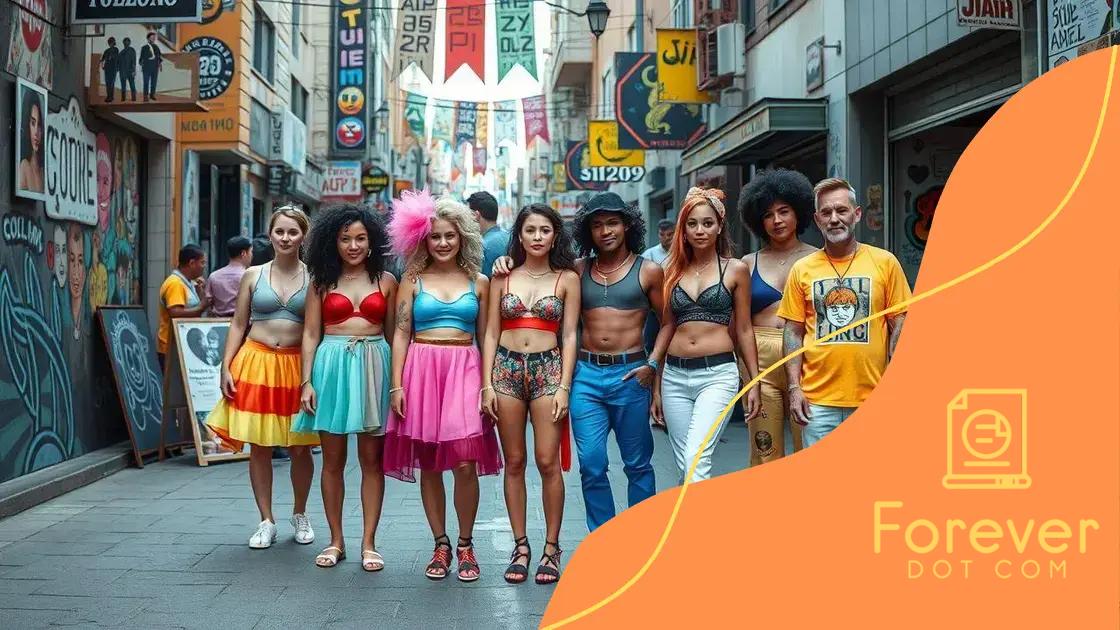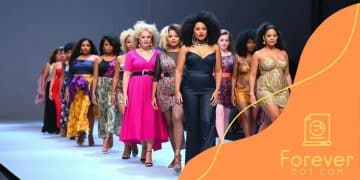Trends in gender-fluid clothing designs: what’s shaping the future?

Trends in gender-fluid clothing designs focus on inclusive styles that defy traditional gender norms, emphasizing sustainability, innovative materials, and representation in the fashion industry.
Trends in gender-fluid clothing designs are changing the way we view fashion. Imagine a wardrobe that defies traditional gender norms and celebrates individuality. Are you ready to explore this vibrant evolution in style?
The rise of gender-fluid clothing in fashion
The rise of gender-fluid clothing has been one of the most exciting developments in contemporary fashion. As society evolves, so too does our understanding of gender and identity. This shift is not just about style; it’s about embracing authenticity and self-expression.
Understanding Gender Fluidity
Gender fluidity refers to a flexible conception of gender that can change over time or depending on the situation. People who identify as gender-fluid may not adhere strictly to traditional male or female categories. Instead, they might express themselves through a blended or varied style.
Key Factors Driving the Trend
- Increased visibility of non-binary identities.
- Support from celebrities and influencers challenging norms.
- The rise of brands catering to gender inclusivity.
These factors contribute to normalizing gender-fluid clothing. As more individuals express themselves, the demand for diverse styles continues to grow. Fashion designers are catching on, creating collections that reflect this progressive mindset.
Moreover, the fashion industry is adopting more inclusive practices. Brands are moving away from using strict gender labels in their collections. Instead, they focus on styles that appeal to anyone, regardless of gender identity. This approach not only fosters diversity but also opens doors for unique, inventive designs.
Influence of Culture
Cultural shifts also play a notable role in the rise of gender-fluid styles. Art, music, and social media have interconnected with the fashion world to spread awareness. For instance, gender-fluid artists often convey their messages through fashion, blending what has traditionally been classified as ‘masculine’ or ‘feminine’ aesthetics.
As gender-fluid clothing becomes mainstream, consumers are empowered. There’s a growing understanding that clothing should be a personal choice and a reflection of one’s identity. Everyone deserves to wear what makes them feel comfortable and confident.
Key designers promoting gender-fluid styles
Several key designers promoting gender-fluid styles are shaping the modern fashion landscape. These visionary creators are redefining traditional gender norms, allowing for more inclusive and expressive clothing options. Their work is a testament to the evolution of fashion in response to societal changes.
Innovative Designers
Designers like Harris Reed and Telfar Clemens are at the forefront of the gender-fluid movement. Harris Reed’s designs often challenge conventional silhouettes, blending elements from both genders to create stunning pieces that embody fluidity.
Telfar, known for his unisex designs, offers stylish and practical options that resonate with a diverse audience. His brand slogan, “It’s not for you, it’s for everyone,” perfectly encapsulates the inclusive philosophy of gender-fluid fashion.
Other Influential Names
- Jacquemus: Known for playful silhouettes and vibrant colors.
- Jaden Smith: Blurring lines between men’s and women’s fashion.
- Rihanna: Her Fenty line includes androgynous pieces.
These designers use their platforms to advocate for gender fluidity and challenge the norms in the industry. They encourage consumers to express their own identities through clothing. By pushing boundaries, they open doors for different fashion narratives and styles that embrace a broader view of gender.
Furthermore, many of these designers collaborate with brands that focus on sustainability and ethical practices. This is an essential part of their mission, merging style with social responsibility. As awareness of these issues grows, the demand for innovative, gender-fluid designs continues to expand.
How cultural influences shape gender-fluid trends

Cultural influences play a significant role in shaping gender-fluid trends in fashion. As society progresses, various art forms, music, and social movements challenge traditional views on gender. This evolving landscape creates a vibrant backdrop for fashion innovation.
Impact of Art and Music
Art and music are at the forefront of expressing new concepts of gender. Artists and musicians often use their platforms to explore and challenge gender norms. For example, pop icons like Billy Porter and Lil Nas X have embraced gender fluidity in their performances, influencing many in the fashion world.
Social Movements
Social movements advocating for LGBTQ+ rights have greatly impacted gender-fluid fashion. These movements encourage individuals to express themselves freely, leading to a broader acceptance of diverse identities. Activism pushes brands to rethink their designs, empowering all individuals to embrace their unique styles.
- The celebration of Pride Month increases visibility for gender-fluid fashion.
- Body positivity movements promote comfort and self-expression in clothing choices.
- Collaborations with activists bring awareness to gender issues within the fashion industry.
Moreover, global cultural exchanges have led to a melting pot of influences. As different cultures share their views on gender and identity, designers draw inspiration from various traditions, fabrics, and styles. This results in innovative, inclusive garments that reflect a wide array of identities.
Young consumers are increasingly looking for brands that align with their values. They seek out clothing that represents not just their style but also their beliefs. This shift is pushing brands to become more inclusive and aware of cultural sensitivities, shaping a new landscape for gender-fluid fashion.
Sustainable practices in gender-fluid fashion
Sustainable practices in gender-fluid fashion have become a vital part of the industry as consumers demand eco-friendly options. As awareness of environmental issues grows, designers are adopting strategies that prioritize both style and sustainability.
Material Choices
Choosing the right materials is essential in the pursuit of sustainability. Designers are increasingly opting for organic fabrics, recycled materials, and biodegradable textiles. By using these materials, they reduce the impact of clothing production on the environment. Eco-friendly fabrics such as Tencel and organic cotton are popular choices that offer comfort without compromising on style.
Ethical Production
- Fair labor practices ensure workers are treated fairly.
- Local production reduces transportation emissions.
- Transparent supply chains promote accountability.
Beyond materials, ethical production methods are key. Many brands focus on fair labor practices, ensuring that employees receive fair wages and safe working conditions. By promoting local production, they also minimize transportation emissions, contributing to a lower carbon footprint.
Additionally, brands are exploring innovative recycling programs. Some offer take-back schemes where customers can return old clothing for recycling or upcycling. This not only extends the life of garments but also reduces waste, making sustainability a cornerstone of gender-fluid fashion.
Consumer Awareness and Education
Educating consumers about sustainable fashion is another important step. Many brands share information on how to care for clothing to prolong its life and decrease the frequency of purchases. By fostering an informed consumer base, the industry can move towards more responsible consumption patterns.
Ultimately, sustainable practices in gender-fluid fashion represent a positive shift towards a more responsible and inclusive future. By merging style with sustainability, designers are setting new standards for what it means to be fashionable in a modern context.
Future predictions for gender-fluid clothing designs
Future predictions for gender-fluid clothing designs suggest that fashion will continue to evolve toward greater inclusivity and creativity. As societal norms shift, the industry adapts to meet the needs of a diverse audience. This transformation opens up new possibilities for how we express ourselves through clothing.
Technological Innovations
With advancements in technology, designers are exploring innovative materials and production techniques. 3D printing, for example, allows for more intricate designs and customization options. This technology can produce clothing that fits an individual’s unique body shape and personal style.
Increased Collaboration
- Collaborations between brands will diversify styles.
- Influencer partnerships create fresh perspectives on gender-fluid fashion.
- More designers will embrace collective projects focused on inclusivity.
Moreover, collaborations are likely to rise. Partnerships between established brands and emerging designers can create exciting new collections that highlight gender-fluidity. Influencers also play a crucial role in shaping fashion trends by sharing their personal styles with their followers.
Inclusivity in marketing is critical. Future campaigns will likely feature models of all shapes, sizes, and gender identities. This approach not only challenges traditional beauty standards but also resonates with consumers who want to see themselves represented in fashion.
Sustainability and Responsibility
Sustainability will remain a priority. As consumers grow more aware of environmental issues, the demand for eco-friendly practices will influence design choices. Brands that prioritize ethical sourcing and sustainable production methods will stand out in a crowded market.
The rise of rental services and second-hand markets will also reshape how people approach clothing consumption. Renting outfits for special occasions or purchasing pre-loved items aligns with a more sustainable lifestyle while supporting gender-fluid fashion.
In summary, the future of gender-fluid clothing designs will likely blend technology, collaboration, inclusivity, and sustainability. As these elements come together, we can expect fashion to become even more personal and relevant to a diverse audience.
In conclusion, the future of gender-fluid clothing designs is bright and full of possibilities. As society continues to embrace inclusivity and diversity, the fashion industry will respond. Innovations in materials and technology will pave the way for unique styles that cater to everyone. By prioritizing sustainability, collaboration, and representation, designers can create garments that empower individuals to express their true selves. Ultimately, gender-fluid fashion will not just be a trend, but a new standard for creativity and acceptance in the world.
FAQ – Frequently Asked Questions about Gender-Fluid Clothing Designs
What are gender-fluid clothing designs?
Gender-fluid clothing designs are styles that do not conform to traditional gender norms, allowing individuals to express their identity freely.
How do designers ensure sustainability in gender-fluid fashion?
Designers focus on using eco-friendly materials, ethical production practices, and promoting recycling to create sustainable gender-fluid clothing.
Why is representation important in fashion?
Representation in fashion showcases the diversity of identities and helps individuals feel seen and accepted in their clothing choices.
What trends should we expect in the future of gender-fluid fashion?
Expect increased technological innovations, collaborations between brands, and a stronger focus on inclusivity and sustainable practices.






